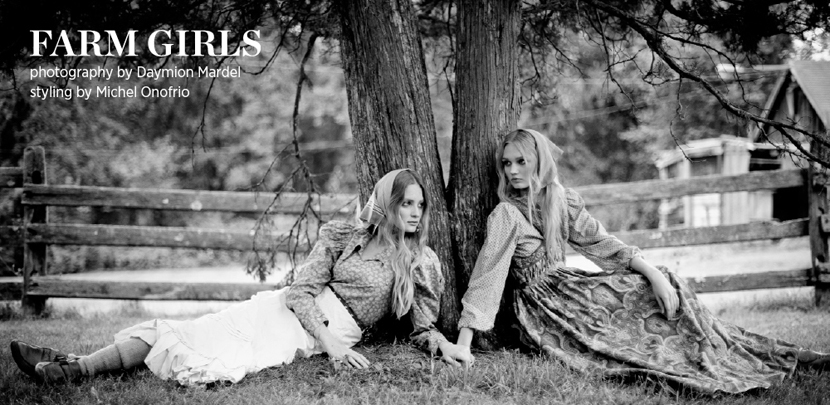

Big Dada

This is a remix album of the largest caliber. Wrongtom, after voluntarily coming up with a dub version of Roots Manuva’s “Buff Nuff,” was commissioned to remix anything and everything from that standout British MC’s entire catalog of four albums. The result is
Duppy Writer — whose Tom McDermott-created cover brings to mind classic albums from the likes of Mad Professor. Wrongtom does justice to the originals by maintaining Roots Manuva’s stellar rhyming skills and singular delivery. What he brings to Roots is a re-imagining of his tracks: it’s as if they were created in another time on an island in the Caribbean. As such, we don’t receive a bunch of vague rehashing, but some fresh, authentic dub and reggae beats and vibes. In keeping with this, Wrongtom renames the tracks, giving them more reggae-ish titles. One of the only original tracks, featuring toaster Ricky Ranking, is “Jah Warriors”, which is a particular standout, as is the militant “Rebuff” — which was the first track Wrongtom re-did voluntarily. Roots’s lyrics and style have never been paid this much respect.
Audio clip: Adobe Flash Player (version 9 or above) is required to play this audio clip. Download the latest version here. You also need to have JavaScript enabled in your browser.
Buy this at Other Music or iTunes.
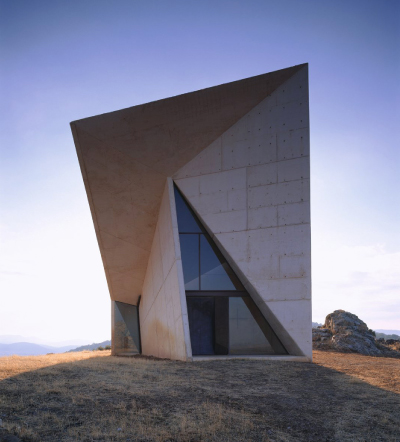
Chapel, Valleaceron, Spain, 2001. By Sancho Madridejos Architecture Office, from Closer to God, Copyright Gestalten 2010. (Click image to enlarge.)

The controversy over the construction of an Islamic cultural center near Ground Zero is surprising when one remembers that New York City is already rich with churches, temples, mosques, and storefronts selling supplies for vodun and santeria rites. It’s hard to remember when another building has caused such a fuss. What is it about this structure, which isn’t even a proper mosque, that stirs up such strong emotions? At a time when our culture seems to have become largely secular, how can a religious building still be regarded with talismanic powers?
A new book that looks at contemporary houses of worship, “
Closer to God: Religious Architecture and Sacred Spaces,” takes up that very question. The structures pictured are eclectic in style, scale, materials, and in the different religions they shelter. There’s a one-person meditation hut in rural New England, an intimate Buddhist shrine in Kyoto, and an auditorium-sized cathedral in Rome. There are churches poured in rough concrete, others built with engineered glass curtain walls, and one clad in battered zinc panels.
If there’s anything these buildings have in common it’s the way that they employ pure geometries and natural light to evoke a spiritual dimension. In this sense, contemporary architects are following in the footsteps of their ancient counterparts. The use of idealized geometries like squares and circles, and the dramatic manipulation of daylight, are practices characteristic of traditional Judeo-Christian and Islamic architecture.
(more…)




The real winners of the 2010 Natural Talent Design Competition are likely to be the residents of the Broadmoor section of New Orleans, a low-lying neighborhood flooded after Hurricanes Katrina and Rita. That’s because the four innovative home designs selected as finalists in the contest will be built in that community in the coming months, bringing affordable, LEED platinum-certified, handicap accessible 800-square-foot houses to a place still badly in need of rebuilding five years after the storms. The designs, created by students and emerging professional architects, will be on view at the Greenbuild Expo in Chicago November 17-19, organized by the United States Green Building Council (USGBC). Once the houses are constructed and evaluated for energy conservation and other aspects of sustainability, a grand-prize winner will be chosen and announced at next year’s Expo. The lucky inhabitants of the soon-to-be-available houses will find rewards over the long term, as the structures are intended to be more efficient than typical homes, and thus reduce living costs.
Pictured with this posting are the houses designed by a group of recent Cornell graduates who have formed ZeroEnergy Design, an architecture and energy consulting firm. The group’s models, titled The Little Easy, feature storm water collection systems, wheelchair lifts for physically impaired occupants, and front porches that serve to tie the new houses to the surrounding properties.
(more…)

By Jonathan Watts. Image courtesy of Scribner

As China goes, so goes the rest of the world. That’s how British journalist Jonathan Watts frames the future. In
When a Billion Chinese Jump, (due out this month from Scribner), Watts outlines two possible trajectories for the world’s biggest carbon emitter: it can reset its current fossil fuel-powered industrial development by becoming the first green superpower, or it can continue on its current course of staggering expansion against a backdrop of diminishing natural resources. On a six-month journey from the foot of the Himalayas to the country’s flat northern grasslands, Watts provides an account of China’s race into the 21st Century and explains the severity of the consequences of its decisions.
The extent of the industrialization currently taking place becomes shockingly apparent in chapters detailing the construction of the world’s largest dams, emerging mega-municipalities like Chongqing, with its thirty-one million citizens, and the pulsating Chinese manufacturing lifeblood.
(more…)

Illustrations and Photography courtesy of JP Thurlowe (Click images to enlarge)

Back in
January, we stumbled upon an interesting reinterpretation of our now famous Issue One cover featuring the notorious Vincent Gallo. Although we weren’t certain of the artist who was responsible for the sketch, we speculated that perhaps the reinterpretation was a rendering by none other than the provocateur himself. Months later, we’ve found the real artist,
John Paul Thurlow. The illustration is a part of the London- based illustrator ’s
100 Covers series, a collection of incredibly stunning and precisely illustrated re-interpretations of contemporary, classic, and little-known covers of magazines. PLANET spoke with JP about his upcoming
100 Covers exhibition at the KK Outlet, Vincent Gallo as a Christ-like figure, and his inspiration behind the series.
What was your inspiration and how did the Covers project come about?
I made a cover version of a 7″ single whilst at college years ago. It was “Yes Sir, I Can Boogie” by Baccara and I was a little confused as a kid about the gender of one of the singers. I loved the idea but forgot about it. The circumstances of the start of
Covers were kind of fucked up. I was made redundant. I got very depressed. I went away on an artistic retreat to Japan. I lived in a Buddhist temple for a while. I started drawing, drawing the contents of my room. There was a copy of Elle I had for the flight. I drew it. I drew it again and again. I knew I had something, the college idea came back to me and I haven’t stopped working on it since then.
(more…)

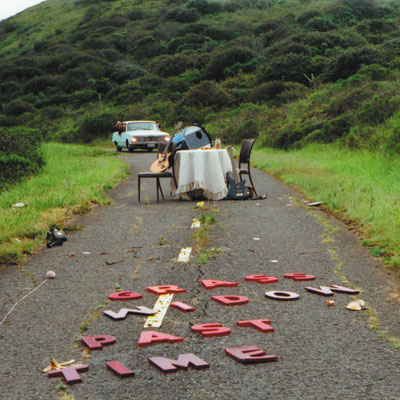
Kill Rock Stars

Original twee-pop from the ’90s seems like a cursed genre — with good bands damned to obscurity and, perhaps, better known for their influence than their actual musical output. (We can argue about this later.) Nirvana put the entire genre on the map by covering a bunch of Vaselines songs. Kurt Cobain got the logo of Calvin Jonson’s (of Beat Happening) record label, K Records, tattooed on his arm, and now we’ve got a bunch of bands sounding just like Black Tambourine and Tiger Trap. All those are really great, but so are many of the ones they’ve influenced.
An all-girl trio from San Francisco, Grass Widow play a bouncy and meticulously interwoven kind of post-punk, as frenetic guitar-picking and bass-plucking create a tumultuous backdrop for their sweet harmonized vocals. And though there isn’t much variety among the songs on the 26-minute
Past Time, Grass Widow’s ability to write complex arrangements with such addictive melodies is the missing link between discord and melodious twee pop.
Audio clip: Adobe Flash Player (version 9 or above) is required to play this audio clip. Download the latest version here. You also need to have JavaScript enabled in your browser.
Buy this at Other Music or iTunes.
(more…)

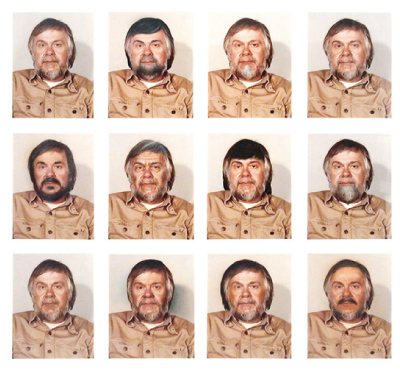
Portrait: (Self) #1 as Control + 11 Alterations by Retouching and Airbrushing, John Baldessari, 1974 (Click images to enlarge)

Painter, teacher, oddball, genius… John Baldessari has defied and surpassed many labels over the course of his career. But above all, nothing seems to fit quite as well as ‘radical’. Considered one of the most influential conceptual artists to come out of the 20th century, Baldessari was bucking the system long before it was cool, and then mundane to do so. A tireless champion of the idea that images and words are interchangeable, Baldessari’s work sought to marry the two entities once and for all. His early paintings earned him a bit of fame that quickly transformed into infamy when he burned nearly everything he’d created between 1953 and 1966 in the dramatically metaphorical, yet very literal, Cremation Project (1970). Baldessari then turned his attention to photography, film, found imagery, and the element of chance to achieve his new world view, drastically changing the way art was made. He hired sign painters and amateur artists to do his bidding, orchestrating elaborate photo series, video projects, and artist’s books such as Throwing Three Balls in the Air to Get a Straight Line. Whenever his interest for a project began to wane, he was off to the next idea— constantly tweaking, modifying and superimposing one philosophy or ideology onto another, looking for answers, challenging perception.
On October 20, John Baldessari: Pure Beauty (on its last leg following stints at the Tate Modern, Museu d’ Contemporani de Barcelona and LACMA) opened at New York’s
Metropolitan Museum of Art. It’s the first major U.S. retrospective of his work in nearly 20 years.
(more…)


Images courtesy of Allora and Calzadilla.


On September 8, 2010, the United States Bureau of Educational and Cultural Affairs announced that the artistic team of Puerto Rico-based Jennifer Allora and Guillermo Calzadilla, who have been working together since 1995, will represent the United States at the 2011 Venice Biennale.
Allora and Calzadilla’s work playfully explores relationships among art, politics and international identity through performances, video, sculpture, photography, sound pieces, and social interactions. It’s interesting to note that they will be the first collaborators, rather than a single artist, to represent the United States and the first time that a combination of performance and installation will occupy the pavilion. This shift toward, a more interdisciplinary art, one hopes, will provide a new space for contemporary artists working outside traditional realms of the art world.
This year marks the 54th Venice Biennale, which in many ways can be compared to the Olympic games of the contemporary art world. More than seventy nations are present. In 2009, Bruce Nauman represented the United States, before that, a posthumous Félix González-Torres. Allora and Calzadilla’s project for the Biennale will consist of six new site-specific works in a display curated by Lisa Freiman, chair of the Indianapolis Museum of Art’s contemporary art department. According to El Nuevo Día, Allora & Calzadilla will prepare six pieces to be placed inside and outside of the U.S. pavilion and will create works that “analyze contemporary geopolitics through the lens of spectacular nationalistic and competitive enterprises such as the Olympic Games, international commerce, war, the military-industrial complex, and even the Biennale itself”.
(more…)

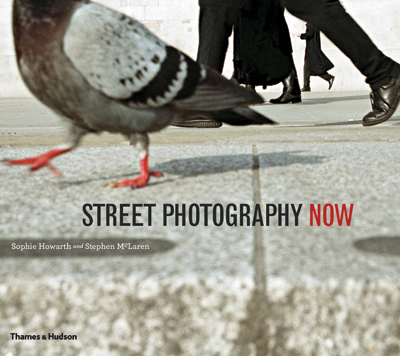
Trafalgar Square, London, 2007. © Matt Stuart. Images courtesy of Thames & Hudson

Street photography goes back at least to the 1930s, when Henri Cartier-Bresson roamed the streets of Paris with his lightweight Leica in hand. But it really came of age in the 1950s, when photographers like Garry Winogrand, Lee Friedlander, and Joel Meyerowitz made a point of spending all day on the streets, catching quirky, serendipitous moments of everyday life. The challenge, always, was to be in the right place at the right time, alert and perfectly positioned to capture what Cartier-Bresson called “the decisive moment” — when background, subject, and mood came together in surprising and revealing ways
In Street Photography Now (Thames & Hudson), authors Sophie Haworth and Stephen McLaren have put together a survey of some of the world’s best street photography at this particular moment. That’s no easy task, of course. The advent of sites like Facebook, Flickr, and Twitpic has made almost all of us into street photographers of one sort or another. To narrow down the task, Haworth and McLaren sought out “the strongest work by the most committed practitioners”, choosing forty-six photographers to represent the genre. Included are are some long-established names — such as Meyerowitz, who’s still going strong fifty years after his debut — but most of the photographers are up-and-coming, in their late thirties and early forties. In other words, they’re old enough to have developed a signature style, but young and energetic enough to pound the pavement every day.
(more…)






 Facebook
Facebook Permalink
Permalink Digg
Digg Reddit
Reddit LinkedIn
LinkedIn StumbleUpon
StumbleUpon Tumblr
Tumblr

